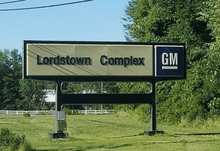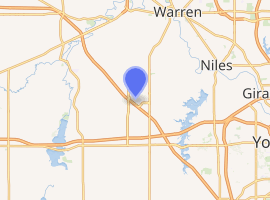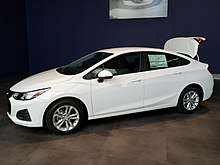Lordstown Assembly
The Lordstown Complex was a General Motors automobile factory in Lordstown, Ohio near Youngstown, comprising three facilities: Vehicle Assembly, Metal Center, and Paint Shop.
 Entrance to Lordstown Assembly from Ohio State Route 45 | |

| |
| Built | 1964-1966 |
|---|---|
| Location | Lordstown, Ohio |
| Industry | Automotive industry |
| Products | cars and vans |
| Owner(s) | General Motors (1966–2019) Lordstown Motors (2019–present) |
| Defunct | March 6, 2019 |
Lordstown was best known for building compact cars for Chevrolet, building the Vega/Monza, Cavalier, Cobalt, Cruze, and their rebadged variants, mostly for Pontiac. The plant also built the Chevrolet van and its GMC variant (Handi-Bus/Handi-Van, Rally Van and Vandura) until 1995.
History
Early years
Originally farmland owned by a local resident, a representative for GM purchased the property in 1955 on GM's behalf, but at the time wouldn't divulge specifics except it would be for manufacturing and that its location along the then-new Ohio Turnpike made it an ideal location for the plant.[1] GM would publicly announce plans for the plant on March 19, 1956 for Chevrolet, with plans to build the division's entire model line except the Chevrolet Task Force and heavy duty trucks, the latter then exclusively built at Willow Run Assembly.[2] Despite plans to open the plant by 1957, the construction began in 1964 and the first Impala rolled off the line on April 28th, 1966.
The plant's initial products were Chevrolet's full-size lineup (Caprice, Impala, Bel Air, Biscayne), then America's best-selling vehicle, as well as the first generation Pontiac Firebird. The Firebird and Chevrolet's full-size models would be moved to other plants by 1971, when the plant would add conversion van production and begin production on the Chevrolet Vega.
Lordstown Strike of 1972
This assembly plant was the place of the notorious Lordstown Strike of 1972, a strike against management at the GM plant.[3] The strike resulted in many defective Chevys coming off the line with torn upholstery and other defects. The strike lasted a total of 22 days and cost GM $150 million. Later strikers elsewhere who similarly engaged in disrupting production lines were labeled as having "Lordstown Syndrome".[4] According to Peter Drucker, a management consultant, it was not just the rigid discipline of the assembly line, or the speedup of operation, but rather that the workers almost unanimously felt they could have done a better job at designing much of their own work than GM's industrial engineers (hence the need to include the floor workers in part of the plant design process).[5] Due to their "hipness" long hair, and mod fashion, the strikers were referred to by the magazine Newsweek as an "industrial Woodstock".
The Lordstown Strike of 1972 was part of the broader mass labor unrest of the 1970s, an era which witnessed the second most labor strikes after 1946.[6] The strike affected the quality of the Vega, and it can be argued that the Vega's overall reliability, caused by the labor issues at the plant, led to the Vega eventually being named one of the worst cars of all-time.[7] Despite that, quality control improved at the plant enough that GM awarded the plant the J-body models for 1981. Lordstown eventually became the sole plant building them.
Later years
Following the collapse of the steel industry in the Mahoning Valley in the late 1970s and early 1980s, Lordstown Assembly became the area's largest industrial employer, though Youngstown State University would surpass Lordstown Assembly as the area's overall largest employer by the mid-2000s; local health care provider Mercy Health would also surpass Lordstown Assembly in total employment.[8] Conversion van production ended in 1994, when the Chevrolet van's successor, the Chevrolet Express, being built at Wentzville Assembly instead, leaving Lordstown to focus exclusively on compact cars.
In 2006, as part of GM scaling back production nationwide, the third shift at the Lordstown plant ceased operations. An employee buyout and early retirements eliminated the need for layoffs. In the summer of 2008, when gas prices soared, the third shift returned in August due to increased demand for the Chevrolet Cobalt, resulting in the creation of nearly 1,000 jobs. Shortly thereafter, General Motors entered into bankruptcy, and two shifts were cut.
During the 2008 presidential campaign, both Hillary Clinton and John McCain made stops at Lordstown. Shortly after election Barack Obama visited Lordstown to celebrate new product announcements and to proclaim success for the auto industry rescue.
In 2010, in preparation to build the new compact Chevrolet Cruze, all members laid off from the plant returned to work. Numerous workers from shuttered GM plants in the US were moved to Lordstown for the open positions.
In 2014, a 2.2 MW solar array was installed, covering six and a half acres with 8,500 solar panels.[9]
Closure and sale
In November 2016, GM announced to end the third shift by January 2017, affecting 1,200 workers.[10] On April 13, 2018, GM announced that the 2nd shift would be cut, eliminating up to 1,500 jobs. The cuts were related to declining sales of the Cruze (and compact cars in general) in favor of SUVs and crossovers, including GM's own GMC Terrain and Chevrolet Equinox, both of which are loosely related to the Cruze and get similar gas mileage numbers as the Cruze.[11][12] GM announced to build the new Chevrolet Blazer in Mexico on the same day Lordstown’s second shift ended.[13]
On Monday, November 26, 2018, GM announced that the plant would be unallocated in 2019.[14] Many, including the area's U.S. representative Tim Ryan, considered the closing their generation's "Black Monday", in reference to Youngstown Sheet and Tube's announcement on Monday, September 19, 1977 that led to the collapse of the steel industry in the area four decades prior.[15]

The last day of production was March 6, 2019. Subsequently, the plant was transitioned to an idled state.[16][3] The final vehicle built at Lordstown, a white 2019 Chevrolet Cruze LS, remained in the area and was delivered to a local Chevrolet dealership after making arrangements with GM to keep the vehicle in the area after a local GM customer requested it; the dealer made a vehicle swap with a dealer in Miami that was originally scheduled to receive the vehicle and was already sold before it left the plant.[17]
Shortly after the shutdown, GM entered talks with electric truck maker Workhorse Group to sell the plant. [18] They required the approval of the UAW, but did not get it until October, following a month-long strike. On November 7, 2019, the plant was sold to Lordstown Motors, which is 10% owned by Workhorse Group, licensing their electric-drive technology. The purchase price was not disclosed, but Reuters reported it was similar to EV start-up Rivian Automotive LLC’s 2017 acquisition of a former Mitsubishi plant in Normal, Illinois, for US$16 million.[19] They plan to manufacture an electric pickup truck called the Endurance there.[20]
Vehicles produced
| Model years | Product | Numbers produced |
|---|---|---|
| 1966–1970 | Chevrolet Caprice, Impala, Bel Air, Biscayne | 453,086 |
| 1967–1969 | Pontiac Firebird | 220,230 |
| 1971–1977 | Chevrolet Vega | 1,966,157 (note:includes additional '73-'74 GM of Canada production) |
| 1971–1994 | Chevrolet Van | 1,948,468 |
| 1971–1994 | GMC Vandura | 423,547 |
| 1975–1977 | Pontiac Astre | 132,046 |
| 1977–1980 | Chevrolet Monza/Pontiac Sunbird | 893,734 |
| 1978–1979 | Buick Skyhawk/Oldsmobile Starfire | 101,907 |
| 1982–1994 | Chevrolet Cavalier/Pontiac J2000/Sunbird | 3,744,631 |
| 1995–1997 | Chevrolet Cavalier/Pontiac Sunfire | 843,741 |
| Total through 1997 | 10,727,547 | |
| 1998–2005 | Chevrolet Cavalier/Pontiac Sunfire | |
| 2005–2010 | Chevrolet Cobalt | |
| 2005–2009 | Pontiac Pursuit/G4/G5 | |
| 2011–2019 | Chevrolet Cruze | |
See also
- List of GM factories
References
- Graziosi, Graig (March 23, 2019). "Remembering when GM came to Lordstown". The Vindicator. Archived from the original on 2019-06-30.
- "Youngstown Vindicator - Google News Archive Search". news.google.com.
- Jaffe, Sarah (2019-06-24). "The Road Not Taken". The New Republic. ISSN 0028-6583. Retrieved 2020-01-30.
- Bunkley, Nick (January 5, 2010). "A Once-Defiant U.A.W. Local Now Focuses on G.M.'s Success" – via NYTimes.com.
- Drucker, Peter Management: Tasks, Responsibilities, and Practices, pp. 277–278
- Cowie, Jefferson (2010). Stayin' alive : the 1970s and the last days of the working class. New York: New Press. pp. 7–8. ISBN 978-1-56584-875-7.
- Collectible Automobile, April 2000
- "Health care leading future of employment in the Valley". December 5, 2018.
- Gauntner, Mike (September 23, 2017). "GM buying wind power for Lordstown plant". 21 WMFJ. Retrieved 2020-01-30.
- Snavely, Brent (9 November 2016). "GM to cut 2,000 jobs amid dropping sales for cars". Detroit Free Press. Retrieved 25 November 2019.
- Grimley, Stan Boney, Nadine (April 16, 2018). "GM Lordstown going down to single shift". WKBN.
- Hall, Kalea. "GM cuts second shift at Lordstown". vindy.com.
- "Lordstown GM plant faces an uncertain future". WEWS. 27 July 2018. Retrieved 26 November 2019.
- "General Motors Accelerates Transformation" (Press release). November 26, 2018. Retrieved November 26, 2018.
- Grzelewski, Jordyn (November 26, 2018). "Idling of GM Lordstown plant 'new Black Monday in the Valley'". The Vindicator. Archived from the original on 2019-07-24.
- Production will end at GM's Lordstown, Ohio plant on Wednesday CNN, March 6, 2019
- "Last Cruze to roll off GM Lordstown production line on display in Boardman". WKBN. March 8, 2019.
- "GM In Talks To Sell Lordstown Plant To Electric Truck Maker Workhorse". GM Authority. 2019-05-08. Retrieved 2019-05-15.
- "GM sells shuttered Ohio plant to EV truck start-up". Reuters. 7 November 2019. Retrieved 26 November 2019.
- "GM sells Lordstown complex to electric-vehicle start-up Lordstown Motors". The Detroit News. 2019-11-07.